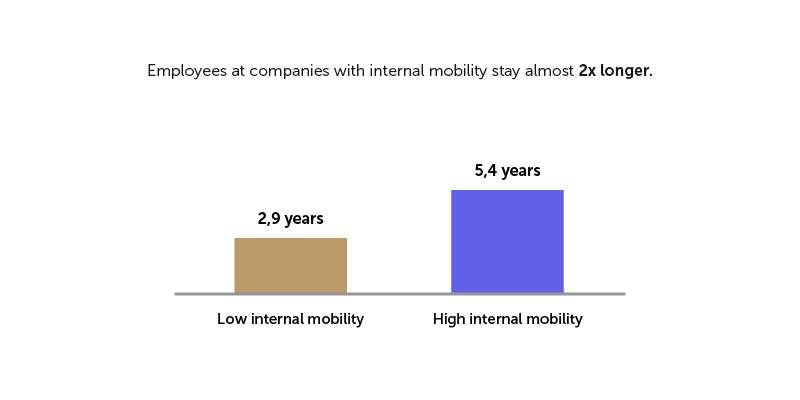How to reskill your employees
Reskilling is a popular buzzword. Learn how to create a successful reskilling program and how to improve the process in your organization.

As industries worldwide continue to evolve through advancements like artificial intelligence, automation, and digital transformation, the workforce is feeling the impact.
According to the Future of Jobs Report 2023 by the World Economic Forum, 23% of jobs globally will experience significant changes over the next five years due to technological disruptions.
To stay competitive and resilient, businesses need to look beyond traditional hiring practices and embrace reskilling as a strategic priority.
Discover:
- What is reskilling and why it is important
- Examples of successful reskilling
- Benefits of reskilling for an organization
- Benefits of reskilling for employees
- How to organize a reskilling program
- FAQs about reskilling
What is reskilling and why it is important?
Reskilling can be a smart alternative to letting go of employees and hiring new talent with different skills. It’s a way to align someone’s natural abilities with the right role.
The World Economic Forum reports that nearly half of core job skills will change by 2027, and around 60% of the global workforce will require additional training.
However, only half of today’s workers have access to sufficient learning opportunities.
This gap presents a significant challenge but also a major opportunity for companies to future-proof their workforce by investing in reskilling initiatives.
Moreover, in the next five years, 23% of jobs around the world will change due to industry shifts, including new AI and tools for processing text, images, and voice.
Examples of successful reskilling
Industries such as manufacturing, customer service, and finance are already seeing the benefits of reskilling.
For instance, in manufacturing, automation has replaced many manual jobs, but companies are reskilling these workers to take on roles in machine oversight, programming, or logistics.
Similarly, in customer service, in-store roles are being reskilled for digital customer support positions, such as live chat consultants.
One financial firm that scaled back on personal investment roles decided to reskill those employees to work in auditing, rather than downsizing. This not only saved the company recruitment costs but also ensured that experienced employees were retained to handle new business needs
Similarly, instead of eliminating in-store personal shoppers, a company might train them to use their customer service skills online as live chat consultants.

How to connect skill building to career mobility
You will get four steps to start developing successful skills development and career mobility programs.
Download guideThe benefits of reskilling for organization
1. Reduce training and hiring costs
Hiring new talent can be expensive and time-consuming.
Reskilling existing employees allows companies to retain institutional knowledge while adapting to new demands.
Studies show that training current staff is more cost-effective than recruiting new hires, saving businesses on recruitment, onboarding, and training costs.
With 82% of companies planning to invest in reskilling over the next five years, it’s clear that organizations recognize its value.
2. Retain company knowledge and improve time to market
Your current employees already know how the company works, and what their roles entail.
This is valuable information that can take months or years to obtain, and when an employee leaves, you lose that company’s knowledge and experience.
Reskilling allows you to keep these knowledgeable employees, so they can pass it on to less experienced employees. A good resource in retaining company knowledge is the knowledge management article.
This also means that the company’s time to market is significantly improved. Time to market is essentially how long it takes a company to produce a product, from the initial conception to putting the product out for sale.
Because employees with solid company knowledge can work without needing as much assistance, tasks are completed more quickly.
As an end result, you get higher quality products, faster production, and better profits.
3. Increased efficiency and innovation
Reskilled employees bring fresh perspectives to their new roles, driving improvements in business processes, reducing waste, and increasing overall efficiency.
By reskilling workers, businesses can adapt quickly to market changes and new technologies without the lengthy process of finding new talent.
4. Reskilling is a great tool for internal mobility
The other good news is that reskilling won’t just help you keep your top employees- it can also help you attract the next round of dedicated employees.
These new employees will want to work for an organization that values its current employees and shows that by helping them expand their skills and roles within the company.
People are much more likely to stay in a company that shows they’re interested in expanding current employees’ roles.

In fact, employees are twice as likely to stay at the same company if they have a chance to expand their roles
5. More versatile employees
As employees expand their skill set through reskilling, they become more versatile in their roles at the workplace- they gain useful insight into other areas in the company.
These employees can become some of your best problem solvers as they know more about the different aspects of your workflow.
This also gives employees a way to elevate their positions within the company.
For example, an employee replaced by auditing software may end up working in technical support. However, because they know how the auditing process works, they may be able to solve complex issues with customer accounts that software alone would not detect. As a result, the employee is promoted to supervising auditing reports.
6. Adaptability in a changing market
The nature of work is shifting rapidly.
As AI, machine learning, and automation become more prevalent, certain jobs are becoming obsolete.
However, these same technologies also create new roles that require human oversight and specialized knowledge.
By reskilling employees, businesses can ensure they have a workforce ready to take on these emerging roles.

How to connect skill building to career mobility
You will get four steps to start developing successful skills development and career mobility programs.
Download guideBenefits of reskilling for employees
1. Keep stable employment (and benefits)
The biggest advantage of reskilling is job security.
In an era of automation, having the ability to transition into a new role ensures employees can maintain stable employment, avoiding job loss.
Additionally, employees retain their benefits, such as healthcare and retirement plans, without the disruption of changing employers.
This stability is crucial, as benefits are the second biggest reason employees stay with an organization (WEF Forum).
2. Upward mobility (role diversity)
Reskilling provides employees with the chance for promotion or role diversification within the company.
It opens up pathways for career growth without the need to seek opportunities elsewhere.
Although a promotion may not always be the direct goal, the skills gained from reskilling can increase an employee’s eligibility for higher or more versatile roles in the future.
This mobility not only fosters job security but also provides employees with a sense of progress and achievement
3. Personal growth and satisfaction
Personal growth through reskilling enhances employees’ sense of accomplishment.
Learning new skills can bring satisfaction, whether it’s transitioning into a new role or improving performance in an existing one.
Employees who invest in their personal development increase their value within the company, gaining greater job security and even opportunities outside of their current organization
4. Making lifelong learning a process
Reskilling encourages a mindset of lifelong learning, a trait highly valued by employers.
Continuous learning doesn’t have to be a complex process—it can be built into daily tasks, but the habit itself enhances personal growth and makes employees more attractive candidates for promotions.
Employers often prioritize workers who show initiative through learning, as it demonstrates a commitment to both personal and company growth

Career development plan template
This template helps employees and leaders plan together for career growth: set goals, assess skills, and make a plan.
Download nowSteps on how to organize a reskilling program
Create a list of potential roles for relocation
Like any good project, you’ll want to start with a plan.
Identify positions that might be eliminated due to automation or other factors, but also focus on the roles your company will need to fill as it grows. It’s not just about replacing jobs—it’s about creating opportunities where people can thrive in new areas.
As you think about future staffing needs, ask yourself:
Will the company be expanding into new markets?
Launching new products?
Offering enhanced customer support?
Use these answers to pinpoint areas for growth and prioritize the roles that will be most important. Remember, not all transitions will happen immediately—some employees might need to finish their current projects first.
Example:
If John’s data analysis role is automated, but he’s great at customer communication, he could be reskilled for a sales position.
Another example:
Jen and Amy are both in the file clerk role. However, Jen has been with the company longer and knows some duties outside of her own. The file clerk role will soon be minimized to include only one employee since much of the work is being replaced by a computer program. Because of Jen’s experience and knowledge, she’s promoted to office manager. Amy is reskilled to take the role of a sole file clerk, which means learning the knowledge Jen has picked up over the years.
Define people who can be included in the program
This is where it gets a bit more complex.
You’ll need to evaluate your workforce to determine who is best suited for reskilling. Not everyone will be a fit for every new role, so it’s essential to define what makes an employee suitable and create a simple rubric for assessing them.
Ask yourself these questions:
- What are the definitions and criteria of the employees eligible to switch roles?
- What departments are to be considered for reskilling?
- How will you grade employees’ suitability for reskilling?
- How do the benefits of reskilling weigh against the risks?
You could keep it simple, like using a 1-to-3 scale (1 being exceptional, 3 needing improvement) or get more detailed with a skills matrix that aligns with the new positions.
Idefine areas for improvements
Even employees who are a good fit for reskilling may need to improve specific skills before transitioning into a new role. This step is all about pinpointing those areas for development.
For example, an employee who excels at sales might need additional training in documentation or processes to take on a more complex sales position. Use performance reviews and feedback to identify gaps and target the skills they’ll need to succeed.
Tip: This guide on areas for employee development can direct you where to look at and what areas you can improve. Look at the skills that your employees already have, and see what they will need to learn to be successful in a new role.
Example: a customer support specialist will be reskilled to take on customer retention roles. The CSR software works much the same for both roles, in essence, however, customer retention requires a little more in-depth knowledge of the system. Therefore customer support specialists will need more training on the advanced aspects of the software to take on their new roles.
Choose reskilling methods
Next, decide how you’re going to train your employees.
You can use workshops, one-on-one mentoring, or digital courses—whatever works best for the roles you’re focusing on.
If you already have a training program for new hires, this might be a good starting point for reskilling as well.
Tip: Learn what employee development methods are better to use for different roles and areas in our guide.
Tailor your methods to the role. For example, a mentoring approach might work best for leadership positions, while group workshops could be great for technical skill development.
Create a detailed plan for key roles and positions
While some roles may only need a basic outline, key roles with more responsibility will benefit from detailed development plans.
The more complex the role, the more time you’ll want to spend mapping out how employees will transition into it.
This ensures they’re fully prepared and the process is smooth.
Define needed time and resources
Just like any other training program, reskilling takes time and resources.
You’ll need to determine how much time each role will require and what tools or platforms you’ll need to facilitate the process.
- Will employees need dedicated mentors?
- Can you use online courses to speed up the process?
- Do you have an LMS or LXP that can help?
Think through these questions to ensure your plan is both efficient and effective.
Discuss the plan with employees
Not every employee will be eager to leave their current role, even if it’s being phased out.
Approach these conversations with care—be transparent about why the reskilling is necessary and how it will benefit them in the long run.
Highlight the job security and opportunities for growth that come with reskilling, and be sure to listen to their concerns.
Tip: You can collaborate on their Career Development Plan, which may motivate and encourage them to work towards their personal goals.
Launch the program, adjust as needed
Once you have everything in place, launch your reskilling program!
But don’t assume the initial plan will be perfect. As the program unfolds, keep an eye on progress and be ready to make adjustments if needed.
Whether it’s tweaking timelines, reallocating resources, or providing extra support to certain employees, small changes can make a big difference in ensuring the program’s success.
By following these steps, you’ll be well on your way to organizing a reskilling program that not only supports your employees but also helps your business thrive.
FAQs about Reskilling
What does reskilling mean?
Reskilling means learning new skills that enable employees to take on new roles within the company, especially when their current roles are going to be eliminated.
What is the difference between reskilling and upskilling?
Reskilling is when workers are retrained to take on a new role in their workplace. Upskilling is similar to reskilling, although upskilling simply involves teaching employees new skills, without the stipulation of taking on a different job role.
How to determine that employees need reskilling?
One of the main indicators that employees need reskilling is that their current roles will be eliminated. When the company wants to retain valuable employees, but cannot maintain the same roles, it’s time to reskill those employees for other roles.
It is also a good option for employees who are really talented in a specific area, or just more effective in something different than their current role. In these cases, reskilling will help them find the perfect role for them and help them to release their full potential.
How long does reskilling take?
The majority of reskilling takes around six months or less. However, the time reskilling takes also depends on the requirements of the new roles employees will assume. Only about 9% of reskilling takes longer than six months but less than a year. It’s estimated that around 10% of reskilling may take a year or longer, although that is likely for more skilled and more elevated roles within the company.




